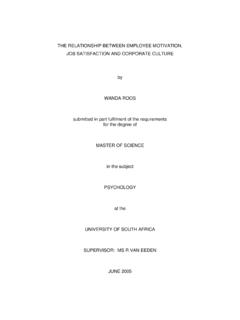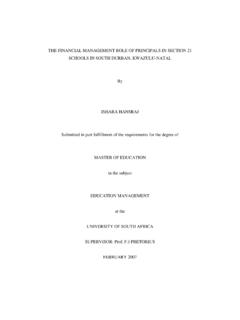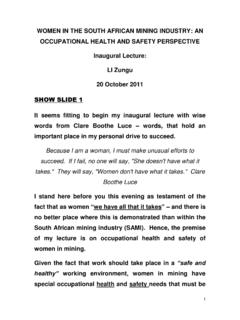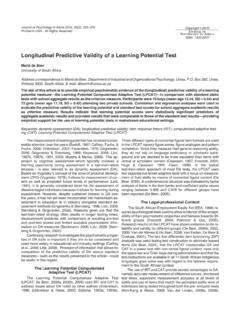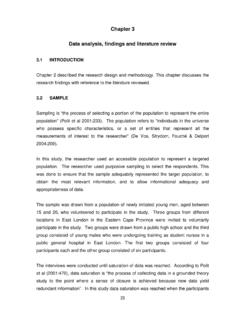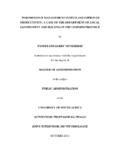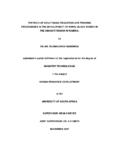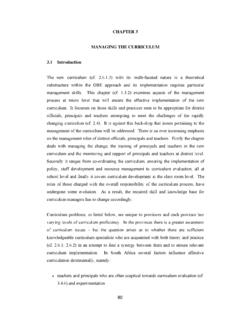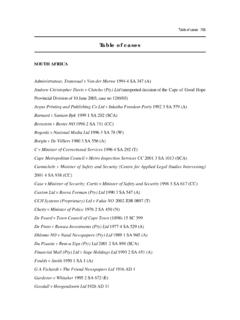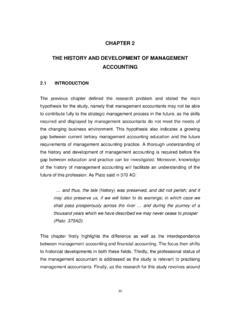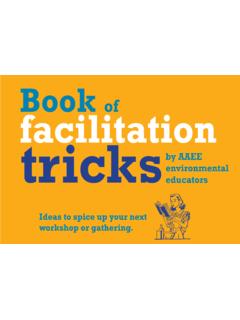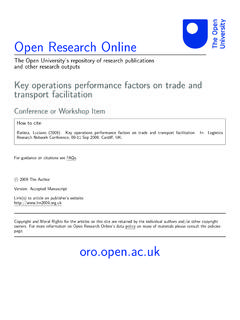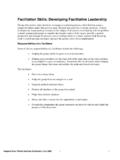Transcription of CHAPTER 3 ANALYTICAL FRAMEWORK AND RESEARCH …
1 CHAPTER 3 ANALYTICAL FRAMEWORK AND RESEARCH and objectivesIn the previous CHAPTER , the RESEARCH problem addressed in this study was embedded in a largertheoretical and conceptual FRAMEWORK . The issues reviewed helped to identify the RESEARCH alreadyconducted in the field of Translation Studies, more specifically translator training, as well as relevantpositions and trends in recent debates regarding this aspect of the discipline. This will help to establishto what extent existing practices in translator training can be adopted for the purposes of this , it was also established that the existing literature on translator training will only partially assistin achieving the aims stated in CHAPTER CHAPTER 1 (par. ), it was stated that the general aim of this study is to revise and improve theAfrican Language Translation Facilitation Course (ALTFC) presented at the Directorate LanguageServices (D Lang).
2 More specifically, the aim of this study was divided into two main and twosecondary aims. The two main aims of this study areRto establish whether the present African Language Translation Facilitation Course (ALTFC) isrelevant within the Department of Defence (DOD) environment considering that candidatesattending the course lack a uniform educational and linguistic background and the set period forthe course is only four weeks; and Rto generate a new and improved course model by incorporating the findings obtained as far , before dealing with the main aims, the two secondary aims will first have to be addressedsince they will lay the foundation for achieving the two main aims. The two secondary aims of this studyare to establish current trends in translator training and the extent to which they can help to improvea translation facilitation course at the level of the ALTFC; and to establish the needs of the DOD, as well as the candidates attending the course.
3 It was also stated in CHAPTER 1 (par. ) that these aims will be addressed by means of a theoreticalcomponent in the form of a literature review (see CHAPTER 2) and an empirical component in the formof survey RESEARCH . However, before launching into a discussion on why survey RESEARCH was chosenas the most suitable RESEARCH or observation instrument and how the survey RESEARCH was46operationalised, how the specific RESEARCH procedures were developed (Babbie 2001: 132; see alsoMouton 1996: 125), the ALTFC, as the object of this study, will have to be described in more CHAPTER will therefore consist of two parts. Firstly, the existing ALTFC as presented at D Lang willbe dealt with. The various modules will be described regarding content, their outcomes/aims and theproblems experienced.
4 The second part deals with the RESEARCH methodology. The operationalisationof survey RESEARCH will be discussed in general followed by a discussion of the Survey for the revisionof the African language translation facilitation course at D Lang in particular. current African Language Translation Facilitation CourseThe current ALTFC is held two to three times a year and lasts four weeks. The courses start on aMonday with the arrival of candidates from units all over South Africa. The actual lectures, however,only start on the Tuesday. Three periods of one and a half hours each are taught per day and an averageof about 10 candidates attend per course. As mentioned earlier ( CHAPTER 1, par. ), candidates are not separated according to languagecombinations but attend classes together.
5 Experience has shown that there are at least five differentofficial African languages in combination with English at each course. One of the problems in this respectis the availability of similar texts with regard to difficulty and subject field in the various official Africanlanguages. Although the merits of holding separate courses for each language combination have beendiscussed, the option has been considered unviable from an organisational and financial point of , it would be rather difficult to get separate courses together for the official African languagesof more limited diffusion, such as Swati or Venda. Since the ALTFC is conceived as an orientationcourse, aimed at sensitising students to think in a translation-relevant manner rather than ironing outlanguage-pair-specific problems, it was considered justifiable to keep the various language combinationstogether and deal with them in one class.
6 Furthermore, the ALTFC is divided into five modules (see Appendix B for the syllabus), namelyIntroduction to translation, Translation strategies, Translation aids, Language skills andWorkshops. While Introduction to translation, Translation strategies and Translation aids arepresented consecutively, Language skills and Workshops are held throughout the course, with thelatter only starting towards the end of the second week and gathering momentum during the last is based on the understanding that in order to hold meaningful workshops at least some formaltranslation knowledge is required. Apart from the Workshops, a short written test is given at the end of every module to assess whethercandidates have grasped the basic concepts presented in the respective module.
7 These tests only containobjective questions, candidates have to tick off yes or no, true or false and name the three .. or47at least three .., etc. Objective questions have been chosen for two reasons. Firstly, they are suitablefor testing the recall of factual knowledge. Secondly, they only require short answers, which is importantsince many candidates still struggle to express themselves in English, especially at a more abstract , tests are not marked for spelling - although spelling mistakes are corrected - but onlycontent. As long as the trainer can make out what the candidate meant, the candidate will get thenecessary mark(s). The pass-mark is 60% since the material is repeated frequently during the classesand candidates have ample opportunity to ask questions.
8 Candidates who fail to obtain 60% have torewrite the test. An attendance certificate is issued at the end of the ALTFC. In the following sections, a more detailed description of the various modules is given, starting withIntroduction to translation. to translation moduleIntroduction to translation comprises different sections: the communication model and the translator,the quotes section, text types and translation methods, as well as text analysis. The translationalcommunication model will be discussed first. communication model and the translatorThe model looks as follows:Source Culture (SC)Source Language (SL)Receiver of ST =Sender of Source Text (ST) Translator = Receiver of TTSender of Target Text (TT)Target Language (TL)Target Culture (TC)The model gives the three main participants in the translational communication process, namely thesender, translator and receiver (see CHAPTER 2, par.)
9 The sender produces a source text (ST)that is written in a source language (SL), which, in turn, is embedded in a source culture (SC). Since inthe translational communication process the sender and the receiver cannot communicate directlybecause of the language barrier, a translator is needed to facilitate communication not only across twolanguages but also two cultures. Apart from introducing a number of translation-relevant terms, themodel clearly shows that the translator is both receiver and sender, the end and the beginning oftwo separate but linked chains of communication (Bassnett-McGuire 1991: 38; see also Gile 1992:187). 48 Moreover, by stressing the role of the translator as a communicator rather than a reproducer, theimportance of making the receiver understand the message becomes evident.
10 Translation is thereforeno longer about right or wrong but about communicating effectively. If the receiver does not understandthe message, communication has been ineffective and thus failed. The above model also helps toillustrate that for communication to be successful the translator does not only need a thoroughknowledge of the SL and the TL but also of the SC and the TC, translation comprises more thanjust languages. Once the connection between translation and communication has been explained (and hopefullyunderstood!) candidates are exposed to some of the thoughts eminent translation theorists have had ontranslation. This is done in the section on quotes sectionThis section intends to broaden the candidates horizon about what translation entails from anideological, linguistic and political point of view, as well as enlarge their translation-relevant what follows, the focus will be on extreme positions in translation theory, such as linguistic relativityversus the Exact Translation Hypothesis, translation as a secondary or proactive activity, equivalence-based translation and translation for empowerment, as well as the relevance of these theories andhypotheses for a course at the level of the ALTFC.
